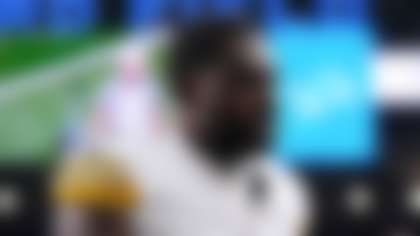TAMPA, Fla. -- Warren Sapp will never forget the day he met Lee Roy Selmon.
"Training camp my rookie year," the seven-time Pro Bowl selection said. Sapp fondly recalls the summer of 1995 when he finally came face to face with Selmon -- the iconic figure Sapp had followed since he was a youngster growing up just outside of Orlando and rooting for the Tampa Bay Buccaneers.
"I looked around, there he was, kind of smiling like he'd always do," Sapp said. "He never had a whole lot to say, but he didn't have to. That wasn't his style. You knew what he meant to the franchise, to the city. Just the fact he showed up meant everything to a young guy like me."
Soft-spoken, humble. In Sapp's words: "The ultimate gentle giant."
That's how friends, colleagues, former teammates and coaches and current Buccaneers defensive tackle Gerald McCoy also remember Selmon, whose impact off the field overshadowed a Hall of Fame football career.
The 56-year-old native of Eufala, Okla., died last Sunday, two days after suffering a stroke. Funeral services are Friday in Tampa and Saturday in Oklahoma City, near where Selmon and older brothers Lucious and Dewey starred at the University of Oklahoma under coach Barry Switzer.
"As a defensive player, without a doubt he was the best I ever had," Switzer said. "It's difficult to compare offensive players and defensive players. But Lee Roy was the greatest defensive player I ever coached and most of the guys who coached with me thought the same thing. We never had anyone else who was as talented as he was."
But as good as Selmon, the first-ever draft pick of the expansion Buccaneers in 1976, was on the field, nearly everyone who knew him insist he was an even better away from the game.
A gracious but extremely private person, Selmon was generous with his time -- whether it be in support of civic or charitable endeavors or as a community ambassador or athletic director at the University of South Florida, where he helped launch one of nation's fastest-growing college football programs in the mid-1990s.
He stepped away from his job as the Bulls' athletic director in 2004 to address what the school said was a "private health matter" that Selmon did not talk about publicly.
"The things he did off the field, the way he gave back to the community, that's really what I learned from Mr. Selmon," said McCoy, a second-year pro who grew up in Oklahoma City and wore Selmon's No. 93 in college at Oklahoma. "I've modeled my game after other players, but how I use the platform this game gives me, that I got from him."
McCoy, like Sapp, met Selmon for the first time after being drafted in the first round by the Buccaneers. Their occasional discussions over the past season often turned to matters outside football.
"He said, 'It's not about what you do on the field, but what you do off the field. How you use your talents to give back," said McCoy, adding that as popular as Selmon was in his addopted home of Tampa, he's even bigger in Oklahoma, where the Selmon brothers are still revered for what they helped the Sooners accomplish before all three went on to play in the NFL.
Lucious, Dewey and Lee Roy, the youngest of nine siblings, all played together at Oklahoma in 1973. Lee Roy and Dewey played together in 74 and 75, when Oklahoma won national championships.
When Lee Roy became the first -- and only -- Buccaneer inducted into the Pro Football Hall of Fame in 1995, he credited his parent with shaping him into a caring and sharing person driven by determination and commitment.
When the Big Eight dissolved in 1996 to join with four Texas schools to form the Big 12, The Associated Press compiled an all-time All-Big Eight team. Selmon was voted the greatest defensive player in conference history.
Oklahoma's record with the Selmon brothers on the field was 54-3-1 with a pair of national titles.
"That's remarkable. But you also admired them even more as persons, as student-athletes. Lee Roy epitomized the student-athlete," Switzer said. "He was the perfect role model for the student-athlete. He was an academic All-American, graduated with honors, NCAA Hall of Fame, academic Hall of Fame. The Lombardi and Outland trophies, college Hall of Fame, NFL defensive player of the year.
"To be the ambassador that he was for our school and our sport was just phenomenal."
Former Oklahoma running back Joe Washington, who played with the Selmons, called Lee Roy "generous, willing to do anything to help you."
"And the key thing about all of it is he didn't have to say anything for you to know this. It was just written all over his face," Washington added. "He did not have to say he would do this or do that. He did not have to say anything. He didn't have to say he was a good football player. You could see it."
Clad in hideous creamsicle-colored uniforms and helmets bearing a winking pirate logo, Tampa Bay went 0-14 in its inaugural season and then lost the first 12 games of 1977. The 26-game losing streak still stands as a NFL record, but Selmon and the Buccaneers were undaunted by the horrendous start.
In the 1979, the team made the playoffs for the first time and advanced to the NFC Championship Game. Selmon was a runaway winner as NFL Defensive Player of the Year.
Two decades later, Sapp became the second player in franchise history to win AP Defensive Player of the Year honors, teamming with Derrick Brooks, John Lynch and Ronde Barber to form the foundation of a defense that would help the Buccaneers win their only Super Bowl in 2002.
"He set a standard way before me, Brooks, Lynch and Ronde -- really all of us there -- that this place was going to be known for defense," said Sapp, who played nine seasons in Tampa Bay and is now a television analyst for NFL Network.
"It's one thing to be a first-round draft pick. I can't imagine what the pressure of being THE guy," Sapp added. "How about that? They bring you as a savior of a franchise that had never played a game, and then they give you the ugliest uniform going and ask you to go do it in that. He made it fashionable to wear icesicle.
"You could put a Lee Roy Selmon jersey on and nobody was going to say nothing to you. You can still wear 63 anywhere, any time and you're golden."
South Florida, which upset Notre Dame last weekend to climb into the Top 25, will honor Selmon before Saturday's home game against Ball State.
The Bulls will wear a number 63 decal on their helmets for the rest of the season. All 19 of USF's teams, including the football squad, will wear the initials LRS on uniforms throughout the 2011-12 school year.
The Buccaneers will pay tribute before Sunday's season opener against Detroit.
"Lee Roy was a guy who led by example. He was never a big, loud boisterous type of person. He always moved in silence," Buccaneers coach Raheem Morris said.
"He was just a guy who came in and was supportive no matter what was going on -- 3-13, 10-6 or 0-0 leading into a really oppotunistic season. He was just a supportive guy."
Copyright 2011 by The Associated Press



